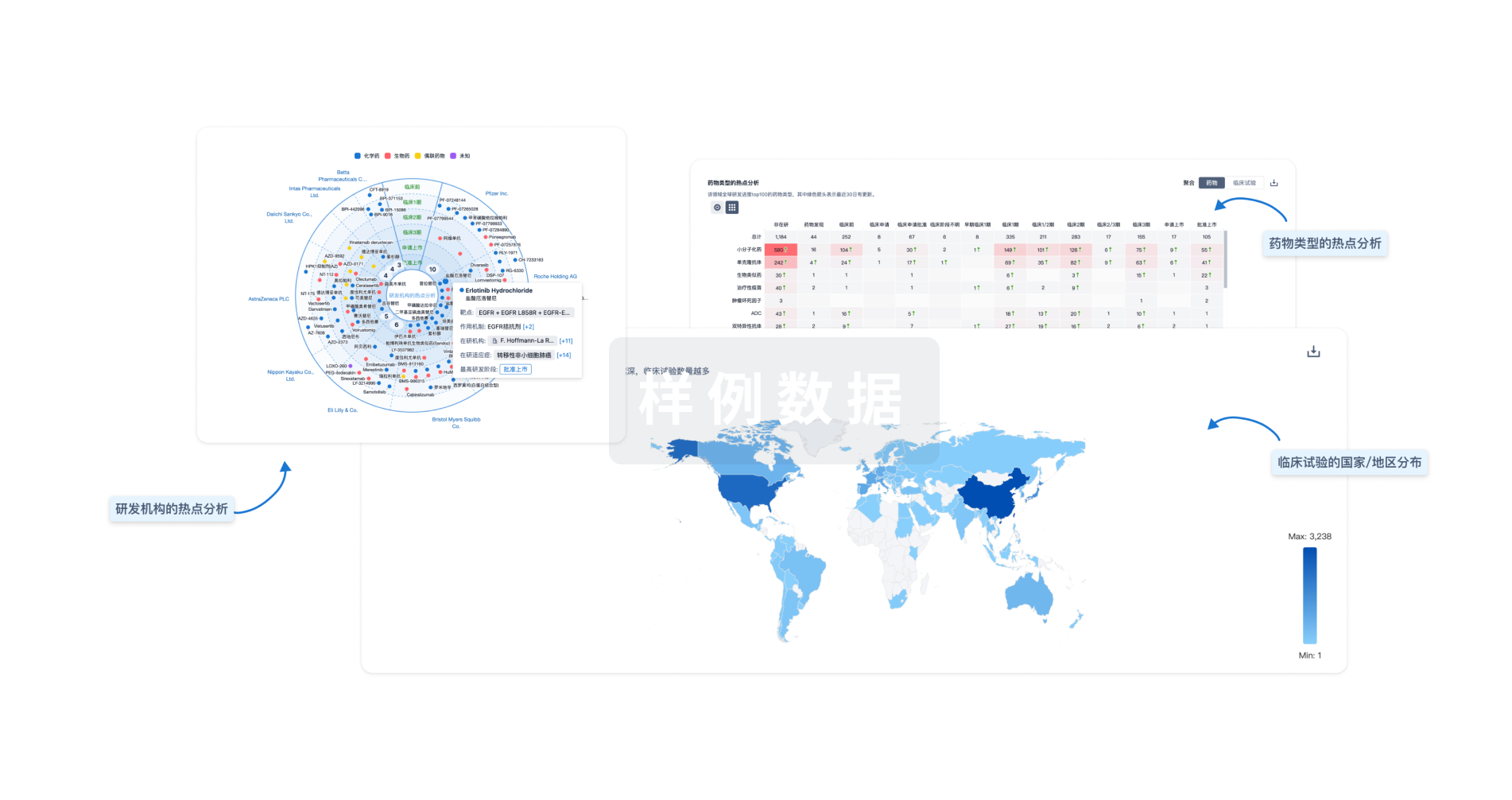预约演示
更新于:2025-05-07
Ablepharon Macrostomia Syndrome
Ablepharon-Macrostomia综合征
更新于:2025-05-07
基本信息
别名 ABLEPHARON-MACROSTOMIA SYNDROME、AMS、Ablepharon macrostomia syndrome + [5] |
简介 An extremely rare multiple congenital malformation syndrome with the association of ablepharon, macrostomia, abnormal external ears, syndactyly of the hands and feet, skin findings (such as dry and coarse skin or redundant folds of skin), absent or sparse hair, genital malformations and developmental delay in two thirds of cases. Other reported manifestations include malar hypoplasia, absent or hypoplastic nipples, umbilical abnormalities and growth retardation. |
关联
1
项与 Ablepharon-Macrostomia综合征 相关的药物靶点- |
作用机制- |
原研机构 |
最高研发阶段批准上市 |
首次获批国家/地区 中国 [+6] |
首次获批日期1994-01-01 |
4
项与 Ablepharon-Macrostomia综合征 相关的临床试验CTR20212354
一项评估T89预防和治疗急进高原期间急性高原反应(AMS)的安全性和有效性的多中心、双盲、随机和安慰剂对照的关键三期临床研究
本项临床试验的目标为评估T89预防急性高原反应(AMS)和缓解急进高原期间AMS症状的安全性和有效性。
开始日期2021-09-20 |
申办/合作机构 |
NCT01923376
Hepatic Encephalopathy: Lactulose or Polyethylene Glycol (H.E.L.P.)
The purpose of this study is to evaluate whether the use of polyethylene glycol is superior and more safe in treating hepatic encephalopathy compared to lactulose and also to determine if treatment with polyethylene glycol will reduce the duration of hospital stay.
开始日期2013-02-01 |
申办/合作机构- |
NL-OMON36915
A Micro Dose Study With 14C Paracetamol, In A Single Dose Two Way Cross-Overdesign With And Without Propranolol In Six Healthy Male Volunteers - Micro dose 14C Paracetamol
开始日期2012-10-29 |
100 项与 Ablepharon-Macrostomia综合征 相关的临床结果
登录后查看更多信息
100 项与 Ablepharon-Macrostomia综合征 相关的转化医学
登录后查看更多信息
0 项与 Ablepharon-Macrostomia综合征 相关的专利(医药)
登录后查看更多信息
442
项与 Ablepharon-Macrostomia综合征 相关的文献(医药)2025-05-01·Journal of Ultrasound in Medicine
Diagnostic Performance of O‐RADS US (Version 2019 and Version 2022) Incorporating Acoustic Shadowing by Junior Radiologists
Article
作者: Peng, Ruan ; Wu, LiHong ; Shang, JianHong ; Xie, HongNing ; Wu, CuiYi
2025-05-01·Clinical Nutrition
Long term impact of formula choice in children with cow milk protein allergy: 6-year follow-up of the Atopic March Cohort Study
Article
作者: Bedogni, Giorgio ; Aquilone, Greta ; Berni Canani, Roberto ; Carucci, Laura ; Nocerino, Rita ; Coppola, Serena ; Masino, Antonio ; Oglio, Franca
2025-03-01·Journal of Occupational & Environmental Medicine
Association Between Male Menopause Severity and Presenteeism
Article
作者: Yamashita, Satoshi ; Fujino, Yoshihisa ; Okawara, Makoto ; Yasui, Toshiyuki ; Horie, Shigeo ; Tateishi, Seiichiro ; Beppu, Hiroki
6
项与 Ablepharon-Macrostomia综合征 相关的新闻(医药)2024-08-02
抓预防、诊疗、康复三端,补齐技术、人员赋能和药品可及三个关键,巩固基层这一“基本”,才能真正提升中国心脑血管疾病诊疗的整体水平。
坐标赣南,地处兴国、瑞金、宁都、于都“通衢要塞”,一片红色沃土之上,于都县第二人民医院坐落于此。周边乡镇约5个,人口近30万。作为于都县北部片区唯一的二级综合医院,于都县第二人民医院是县域紧密型医共体建设的一道缩影,深耕“基层”,见证“基层”。
无论是肿瘤防治,还是慢病防控,前沿阵地都在基层。这一环节,最靠近老百姓,却在整个医疗体系中最薄弱。以慢病中最高发类型之一的心脑血管疾病为例,当前基层医疗机构对心血管疾病诊治能力较弱,在预防筛查和康复端更是存在极大的空白。补齐这一环,需要加速医疗资源下沉,医护工作者赋能,以及药企推动心血管用药可及性。
2024年,一场名为《心动力量——重走长征路》的系列活动,集结院士、约百位心血管领域专家和药企,以长征之路的红色背景,深入基层,提供经验分享和技能指导,着力于构筑基层心脑血管疾病全生命周期管理的能力建设。首站落地长征出发地于都,活动在于都县第二人民医院成功举办,主要内容包括专家义诊、联合查房和研讨会。
E药经理人有幸走近首场“心动力量-基层行”,与中国工程院院士、山东大学齐鲁医院张运,数位顶尖专家及深耕心脑血管领域的天士力一道,进行了面对面访谈。
众人认为,必须加速推动医疗资源下沉,让基层医疗机构抓“本手”,基层医疗服务抓精细,进行人员、技术赋能,提升药品可及性,从而探索出一条长期的可行性路径。
中西医融合基层心脑血管病防治研讨会暨“重走长征路”基层赋能系列活动启动仪式
01
基层已成心脑血管疾病防控主战场
2023年,国家卫生健康委、国家发展改革委等14部门针对我国心脑血管疾病频发现状,联合印发了《健康中国行动—心脑血管疾病防治行动实施方案(2023—2030年)》。
文件提出,到2030年,要建立覆盖全国的心脑血管疾病综合防控和早诊早治体系,进一步改善各级医疗卫生机构心脑血管疾病防治能力和质量,有效控制心脑血管疾病发病率及危险因素上升趋势,将心脑血管疾病死亡率下降到190.7/10万以下。
文件强调,要以基层为重点,预防为主,中西医结合。
心脑血管疾病——心血管疾病和脑血管疾病的统称,泛指由于高脂血症、血液黏稠、动脉粥样硬化、高血压等所导致的心脏、大脑及全身组织发生缺血性或出血性疾病等,其多数病种为长期慢性病。
近年来,心血管疾病已成为全球死亡率最高的疾病之一,普遍表现为“三高”态势:高发病率、高患病率和高死亡率。在我国,随着人口老龄化和生活方式的转变,健康人群患心血管疾病的风险在持续加大,这给诸多患者家庭带来了巨大的经济负担。
另外,近10年,我国心血管疾病领域逐渐呈现一个明显趋势:相关数据显示,从2015年起,我国农村地区心脑血管疾病死亡率已经超越城市。2022年,我国农村心脑血管疾病的死亡人数占总死亡人数的48%以上,超过城市45%的比例。城乡居民疾病死亡原因构成中,心脑血管疾病占比超45%,即平均每5例死亡中有超过2例源于心脑血管疾病。
可以看到,解决基层地区民众心脑血管疾病诊疗问题,已成为一项迫切的任务,然而当下还存在诸多痛点亟待解决。
一方面,基层地区心脑血管疾病患者基数大,老年人口比例高,但防控意识薄弱,对预防筛查、诊断、康复的认知差。高危筛查率低,“三高”控制达标率低,高危人群用药治疗率也较低。
另一方面,基层医疗机诊疗手段有限、诊疗能力相对薄弱,基层人才队伍建设不足。
“中国心血管高危人群的数量不得不引起重视,尤其是患有高血压、糖尿病和高血脂的人群。”张运院士在接受采访时强调。面对庞大的患者基数,想要实现一级预防,改变生活方式管理,这就需要有强大的基层防治队伍,构建坚固的基层防治能力建设,动员基层去完善预防、诊疗和康复端的不足。“如果基层抓不好,中国心血管疾病防治尤其成问题。”
中国工程院院士、山东大学齐鲁医院张运院士
尤其在康复上,在张运院士看来,由于认知不到位、经济压力、医疗资源分配不均等因素,基层康复治疗在心脑血管疾病的整体治疗过程中极易被忽略,但其对患者的全面恢复和提高生活质量具有至关重要的作用。
此外,中西医结合特色优势应用于基层的力度还不够。
几位受访者不止一次强调了中西医结合对于心脑血管疾病防治的关键。“在心血管系统疾病中,现代医学发展非常快速,这是不争的事实。但同时中医药学过数千年的积淀,在这一领域里的地位也是有目共睹,其临床疗效、预防理念、康复措施,都很有效。如果能够结合起来,扬长避短,取长补短,就会让患者更加获益。”天津中医药大学第一附属医院毛静远在采访时尤其谈到了这一点。
天津中医药大学第一附属医院毛静远教授
02
一线视角看问题
于都县第二人民医院义诊活动现场,10余位顶尖专家亲临,为百余位前来咨询的患者解答疑惑,通过问诊、查体、查看病历资料等方式,全面了解患者的病情,并给出了专业的治疗方案及康复建议。
于都县第二人民医院义诊现场
在他们的第一视角里,一幅基层地区心脑血管患者诊疗现状图跃然眼前。
新疆医科大学附属中医医院安冬青观察到,前来就诊患者以老年人为主,患有糖尿病、呼吸道疾病的占据多数,患者大多都是多病共存,比如有患者既有脑血管病,又有心血管病,还同时患有糖尿病和慢阻肺。
此外,让安冬青印象深刻的是,不少患者服用中药、西药的时间、剂量、服法存在一定问题,很可能会使得药物之间发生相互作用,影响疗效,甚至可能会出现毒性反应。
新疆医科大学附属中医医院安冬青教授
据上海长征医院吴宗贵回忆,在细致询问病史时,发现患者多数还患有高血压,有的还有脑中风后遗症、得过急性心梗等等。
上海长征医院吴宗贵教授
上海交通大学医学院附属瑞金医院张瑞岩,则在与当地患者沟通交流时注意到,很多人在发病之前,基本没有什么预防和诊疗意识。有的患者同时有“三高”,但没有采取任何预防的措施,甚至都没有这一意识,直到最终发病才前去就医。“这是一个非常被动的过程。”张瑞岩感慨。
上海交通大学医学院附属瑞金医院张瑞岩教授
以上观察,皆反映了基层地区患者端最为关键的问题:对心脑血管疾病筛查、诊疗、康复的认知,还较为欠缺,甚至是一片空白,缺乏自我管理的知识和技能。
而关于基层医疗机构诊疗端,“医疗资源配置分布不平衡,不充分,基层医疗机构诊疗能力和队伍建设相对仍较薄弱,存在较大差距”。这是天津中医药大学第一附属医院毛静远,南昌大学第二附属医院杨人强共同的感受。
南昌大学第二附属医院杨人强教授
“人才较少,创新较少,研究较少”,张运院士在接受采访时更是坦言。在他看来,目前,尽管国内很多基层医疗机构在“硬件”,即医疗设备、引入技术上较此前有很大提升,但“软件”——基层医护人员的综合水平还较差,人才队伍培养和建设亟待完善,缺乏职业教育培训,基层医生自我提升渠道有限,广大基层医生群体总体水平也存在参差不齐的问题。
张运院士认为,基层环节在心脑血管疾病预防、治疗以及康复“三大防线”上,扮演着举足轻重的角色,但能力建设还不够。拿治疗端来说,院前医疗急救服务速度效率亟需提升,一个制度化、体制化的诊疗体系,也需要优化。另外,技术力量不足,防治宣教需加强,康复也还需培训。
再一个是“防、筛、治、康”之间存在信息孤岛现象。多位受访者认为,基层医疗机构的信息化水平普遍较低,有些机构难以根据心脑血管等慢性病的特征提供有效的信息化管理,这导致患者信息无法连续、及时获取,从而影响疾病管理效果。
那么,该如何加强基层心脑血管疾病的诊疗水平和全周期管理能力?
03
如何控制在基层?
“基层的医护人员首先自身要提高对疾病的认识,及时跟进最新研究进展,提升心脑血管疾病防控能力。如果小病不在基层看,等到大病时候去大医院看,对于很多偏远地区患者来说路途又遥远,费用又高,实际还会花费更大的成本。”有受访者这样认为。
而提升基层防控水平,一重在提升服务与质量,二重在“全周期”覆盖,三重在人才队伍的建设。
受访者们一致认为,必须加大基层医疗投入,改善基层医疗机构的硬件设施和诊疗条件,提高基层医生的诊治能力,引进国内外先进的心脑血管疾病防治技术和设备,提高基层治疗水平。
专家团联合查房
同时,继续加强基层医疗机构与上级医院、科研机构等之间的合作与交流,共同研究心脑血管疾病防治的新方法、新技术,推动科研成果的转化和应用。依托县域紧密型医共体建设,制定完善的培训制度,以知识讲座、临床带教等方式加强基层医生的业务水平和综合能力。
另一边,切实完善基层医疗卫生人才队伍的建设,促进人才引进与培养、通过业务培训等方式提升能力与素质,完善相应的激励机制等。
恰如此次系列“心动力量-基层行”的目的,通过开展系列学术活动,为基层医疗机构的临床医生提供学术交流平台,让心脑血管领域专家学者分享交流最新研究成果和经验,促进基层医生间学术交流和合作。另外,通过义诊、联合查房等活动,具体捕捉医疗需求,提供医疗技术和丰富经验。
《健康中国行动—心脑血管疾病防治行动实施方案(2023—2030年)》指出了几大具体工作措施,对应内容,也正是几位受访者所呼吁的。
一是加大全民健康教育力度,不断提高健康素养。
在受访者看来,要“经常下基层”“深入基层”,加大科普教育力度,建设权威的科普信息传播平台,提升基层地区民众对心脑血管病的知晓率;同时推广健康的生活方式,如合理膳食、适量运动、戒烟限酒等,以降低心血管疾病的风险因素。
另外,政府部门、医疗机构与药企等多方要积极合作,多开展心脑血管疾病防治的科普教育活动,向基层地区患者普及药物知识,包括药物作用机制、用法用量、注意事项等,提高用药依从性。
二是强化关口前移,创新心脑血管疾病同防同治路径,加大基层医疗机构“三高共管”力度以及早期筛查和早诊早治力度。此外,要推广智能化预防与诊疗技术,提升基层医疗机构服务能力和质量。
这一点,恰如受访者所强调的,要覆盖心脑血管疾病全周期、一体化、全流程管理,注重从“治已病”向“治未病”转变。而探索心脑血管疾病同防同治路径,背后原因在于,心血管疾病和脑血管疾病有着共同的发病机理和危险因素,常常伴随发现。同防同治,可以降低救治患者的难度和危险性,提升治疗效果。
三是完善急救体系,提高规范化、同质化诊疗水平。加强急救知识与技能普及,加强院前医疗急救体系建设,畅通院前院内一体化急救绿色通道,实现院前急救与院内急诊有效衔接。
四是加强临床医学研究和协同网络建设,持续提升我国心脑血管疾病防治的整体科技水平,加快科技成果转化与推广。
值得注意的是,这一点,强调了相关企业在构建基层诊疗能力的重要性所在。药企要结合自身资源禀赋和战略定位,推动药物可及性,从实际需求出发,研发适合基层使用的、价格合理、疗效确切的药物,让基层地区患者有药可用、有药可选。同时,加强与基层医疗机构建立紧密的合作关系,实现资源共享、信息互通。
例如,天士力在心脑血管、消化代谢、肿瘤等疾病领域探索多年。其核心产品复方丹参滴丸多年来在中国公立医疗机构终端的心脑血管中成药品牌排名中稳居首位。
天士力医药集团医学市场部刘晋平在接受采访时表示,今年是复方丹参滴丸上市30周年,基于30年的沉淀,天士力接下来还将积极探索复方丹参滴丸更多的可能性,承担社会责任,为推动心脑血管疾病防治贡献力量。如在目前,复方丹参滴丸(T89)治疗慢性稳定性心绞痛适应证与防治急性高原综合症(AMS)两项关键国际临床试验正在如期推进中。
天士力医药集团医学市场部刘晋平
2030年,要将心脑血管疾病死亡率下降到190.7/10万以下。这是一道时代的命题,也是医药产业各方的使命和责任,实现这一目标的重要落脚点,即将其控制在基层。但这三点,离不开政府、产业和科研的多方共同努力,更离不开秉持长征精神的内核:锲而不舍,并在探索之中善于发现契机,这也是《心动力量——重走长征路》系列活动的内核所在。
一审| 黄佳
二审| 李芳晨
三审| 李静芝
2024-05-29
·赛柏蓝
人工智能正在往各行各业渗透,中医药领域也迎来了自己的超级“大脑”。 01中药创新痛点、难点亟待破局中医药行业迎来“超级大脑”自从2018年以来,人工智能开始往多个行业渗透,现今,渗透的速度越来越快。人工智能如何应用到核心业务中?人工智能如何解放企业生产力?针对这些问题越来越多的企业开始思考,中药企业也不例外。5月9日,在天津天士力举办了一场不同寻常的会议——数智赋能大健康产业新质生产力暨第四届中医药国际发展大会,在会议上,中医药行业的“超级大脑”“数智本草”大模型发布。早在2022年11月,国家中医药管理局印发《“十四五”中医药信息化发展规划》提出,加快中医药关键数字技术攻关,方向之一即针对制约发展的关键问题,依托高水平研究机构、高等院校、中医医院以及中药创新企业,开展政产学研用协同创新,鼓励和支持智能中医设备研发及应用。中药创新的痛点、难点也期待着全新的解决办法。一方面,近年来中药新药获批品种数、申报上市品种数及申报临床品种数均呈逐年递增态势,尤其是2020年新版中药注册管理办法实施后,中药1类新药的申报呈现井喷态势;另一方面,与化学药、生物药相比,中药新药研发难度更大,因为其物质基础及药理机制更为复杂,对其安全性、有效性等方面的研究,需要新方法新技术。长久以来,中药面临着原料质量波动大、物质组成复杂、毒副作用认识不足、作用机制不清等问题,现代中药产业的发展依旧存在瓶颈。同时,由于中药缺乏符合中医药特色的临床证据与科学验证,也制约了自身的临床应用与推广。随着大数据、云计算等人工智能技术的迅猛发展,中医药行业发展也迎来了新的引擎-“数智化”。02坐拥海量数据的“数智本草”全球首个中药研发多模态大模型这次会上发布的“数智本草”大模型是基于华为澎湃算力与向量库等先进工具,由天士力与华为云在华为盘古大语言模型和盘古药物分子大模型的基础上联合开发的中医药语言大模型和计算大模型,这也是全球首个数智中药研发大模型。目前的“数智本草”大模型1.0版本,通过智能问答,报告生成以及交互计算三种模式,推进中药复方、药材、成分从筛选、优化到临床等全研发链条的证据挖掘、辅助决策及效能提升。相比于传统模式,“数智本草”大模型将使用户直接面对中医药研发的核心问题。1)智能问答。用户只需要把问题提交给问答系统,即可获取想要的答案。进一步的,通过优化问题,以及选择合适的资源库,可以获取更精准的答案。2)交互式计算。用户在智能问答对话框,输入想要做的分析工作,进行简单的选项配置,即可获得分析结果。3)报告生成。用户对指定的方剂、疾病、中成药,只需要提供相关的必要信息,也可以添加个人知识库信息,即可生成相应的报告文档。让用户在短时间内360度了解相关药物和疾病。目前“数智本草”大模型集守正(1000+古籍及翻译,9万+方剂,4万+中成药信息等)、创新(4千万+文献摘要,3百万+天然产物,2万+靶基因通路信息等)、产业化(10万+临床方案,16万+中药专利以及药典政策指南等)三大类海量数据于一身,相比其他中医药大模型有更加全面的全产业链数据。比如,“数智本草”语言大模型,拥有380亿参数量,基于中医药海量文本数据预训练,结合向量库检索强化,以及中药研发多场景的微调,能够更好地帮助研究者完成中医药理论证据的挖掘和总结;“数智本草”计算大模型,基于数十亿分子结构的预训练,使用350万特有的天然产物分子数据微调,能够更精准地执行“表征天然产物分子、提高下游属性预测”等计算任务,并可结合相应算法快捷实现药材与复方的筛选和优化。“数智本草”大模型紧紧围绕中药研发全流程对信息提取、文档撰写和数据分析的需求而开发,有望大幅度提升天士力中药研发效率,加快创新药的上市速度,实现数智中药研发升级。但是,“数智本草”大模型的应用还不止于此。数智本草”大模型还可以拓展对医药营销、专病开方等场景的赋能,赋能医生和药店店员,为市场带来更多的选择和价值。现代中药创制全国重点实验室常务副主任、天士力医药集团董事长闫凯境博士指出,通过建设中医药“数智本草”大模型的智能一体化平台,希望打造“数智中药”资源、研发、制造、供应、临床应用、消费者认知新范式,实现中药产业全链条飞跃性转型升级,助力中药研发进入数智中药时代,推动中药现代化和国际化进程。03从现代跨越到未来数智中药是明确方向什么是数智中药?数智中药以人工智能等颠覆性科学技术为突破,创新性配置包含中医药海量数据的新型生产要素,结合云计算、大模型等新型技术手段,通过中药产品的组方配伍数智化、物质基础数智化、量时毒效数智化、生产质控数智化、临床应用数智化、消费认知数智化,引领现代中药达到用药精准、生产精智、疗效精确的新高度。以“六化三精”为核心内涵的数智中药,已成为天士力现代中药走向未来的明确方向。在数智中药的发展过程中,逐步形成了3条关键路径:一是以多维度多模态数智中药研发技术深刻解析药物与疾病特征的路径;二是以智能制造技术保障中药产品质量精准控制、高效、绿色、可持续发展的路径;三是以智慧中医大脑高效赋能数智中药个体化精准服务的路径。数智中药全链条覆盖研发、制造、诊疗。天士力基于这3条关键路径,全力打造“星斗云”中医药特色数智平台,在中药作用机理解析、疾病机制解析和指导中药新品种开发中发挥重要作用;创建“以质量数字化为核心的中药智能制造技术体系”,科技成果经鉴定达到国际领先水平,并获2022年天津市科学技术进步特等奖。数智中药研发的关键内容是“说理”和“寻药”,融汇传统中医药理论与现代医学、系统生物学等多个学科。近年来,天士力利用AI赋能中药“说理、寻药”,通过“从方到病、从病到方”两大路径,全力打造“数智中药”研发新范式。“从方到病”天士力在多年研发实践中,积累海量的中医药数据,自主研发创建“星斗云”系统,能基于已有的方剂、已上市的产品,运用知识图谱等技术,针对“方”形成“药效组分”-“作用靶点”–“基因网络”的中药数字化解析方法。“从病到方”天士力与华为共建推出的“数智本草”大模型,是对已有“星斗云”系统的升级迭代,助力中药创新研发。一方面基于华为的语言大模型为解析中医药提供更好的工具。另一方面基于华为的盘古分子大模型,能够帮助天士力将多年积累的将近350万个的天然药物分子的数据,形成专属的天然药物模型,并为打造复方药物模型提供一种可能——这是天士力与华为共建大模型在药物研发方面的助力,为实现“数智中药”的发展蓝图提供了方法与路径,进一步结合病证基因网络的分析,重新进行中医药组方,真正打造“从病到方”。数智中药将突破传统中药毒副作用模糊不清、药材质控经验化(人工筛选、以形定质)、生产质控凭借形、性、味判断,无精确标准等局限性,实现毒副作用清晰可知、精准可控;药材质控智能鉴别、全程追溯;并基于物质基础、量效关系、靶点网络、患者需求精准使用药物。随着数智中药的发展,基于精准、透彻的中药物质基础解析,将促使中药回归安全、有效、质量可控的药物本质。同时,数智中药的长足发展将带动中医现代化的进程,促进传统中医与现代科技相结合、加速中医理论现代化及多学科交叉融合、精准且量化早期和预后的中医诊断、指导科学严谨地设计临床试验,合理选择临床替代指标、推动中医服务模式持续优化,以期提升中医药行业的现代化水平,加速数字化转型,实现中西医并重、中西药并用。最终,数智中药的物质靶点网络结合中医辩证施治网络和人体基因网络,实现 “药—证—病”三网融合;突破传统中药的经验模式,实现数据+机理驱动、精准导向、源头设计、智能制造,最终基于患者基因表达模式和 “药—证—病”网络特征,精准回归个体化治疗。04率先推出中医药行业超级大脑天士力跻身中药创新领域龙头为什么是天士力率先推出中医药行业的超级大脑?是坚持不懈的创新投入,积年累月的数据积累;也是坚定的战略转型,是企业的责任与使命。2023年天士力研发投入13.15亿元,同比增长29.49%,其中研发费用9.17亿元,同比增长8.51%,已经成为A股中药赛道领跑者,跻身中药创新领域龙头。创立三十年来,天士力从传统中药到现代中药,走向数智中药,数智这个关键词在天士力2023年的业绩答卷中高频出现。2023年,天士力与华为云签约共建中医药大模型,结合天士力中医药特色数据和华为云盘古大模型,加速现代中药创新与转化。同年,天士力现代中药创制全国重点实验室组建成功,“科创中国”现代中药研发创新基地持续赋能。2023年,天士力的研发管线高效推进,通过“四位一体”的研发模式拥有涵盖 98 款在研产品的研发管线,包含 41 款 1 类创新药,36 款处于临床试验阶段,26 款正在临床 II、III 期阶段:2 款中药经典名方枇杷清肺饮、温经汤提交生产申请;9 款创新中药处于临床 III 期研究阶段,包括安神滴丸、青术颗粒、脊痛宁片、安体威颗粒、苏苏小儿止咳颗粒、香橘乳癖宁胶囊、连夏消痞颗粒、T89 治疗慢性稳定性心绞痛适应症与 T89 防治急性高原综合症(AMS);安神滴丸、注射用重组人尿激酶原(普佑克)急性缺血性脑卒中适应症 IIIc 期验证性试验、安美木单抗 IIb 期临床试验完成全部病例入组;B1344 注射液获得非酒精性脂肪肝炎(NASH)适应症临床批件;化药利伐沙班片、注射用尼可地尔获得药品注册批件,尼可地尔片通过一致性评价,盐酸达泊西汀片、巴氯芬口服溶液、托拉塞米注射液提交生产申请。研发硕果不断背后,是天士力持续聚焦心脑血管、消化代谢、肿瘤三大疾病领域,同时拓展尚未有有效治疗药物的疾病领域(如中枢神经、自身免疫性疾病领域),在“四位一体”研发模式的基础上,以中医药大模型为引领,将中医药理论知识、临床经验与大数据、人工智能等现代科技结合,发展新质生产力,打造中药数智化研发制造体系。此外,天士力推动新型技术平台、创新生物医学工程技术产品等市场化进程和关键核心技术开发应用,并通过产业投资基金,围绕现有产业资源,通过产业并购基金布局,尽可能为公司获取商业合作机会,进而推动自身持续发展。不止步于研发,天士力全链条推动数智化转型,数智营销、智能制造。基于行业政策变化、疾病谱演变趋势、药物研发及治疗理念更新迭代、数字化与智能化升级等的未来趋势,天士力以用户为中心不断推动诊疗一体化整合营销战略,塑造产品影响力及核心价值。同时构建优势领域产品矩阵,加强产品专业推广及核心门店管理,提供覆盖客户健康全生命周期的数字医疗服务集成解决方案,全面提高市场覆盖率和渗透率。天士力持续强化数字化转型,打造数智化的医疗健康服务创新模式,提供覆盖客户健康全生命周期的数字医疗服务集成解决方案,持续推动创新产品进入更广泛的临床应用。加速数字化平台搭建和数字化内容营销,通过数字化、自动化的数据处理流程,促进企业终端渗透,持续提升基于大数据分析的运营决策能力与营销资源体系整体的优化配置能力,形成数据驱动营销效能提升的管理闭环。生产制造方面,天士力以精益增效为核心,推动全面的智能制造。天士力持续推动现代中药、化学药、生物药智能制造协同升级。在现代中药领域,针对关键生产线在提高质量与效率、降低人工与能耗等方面的需求,深入推进智能制造体系升级,加快复方丹参滴丸第二条智能包装线投产以及其他重要生产线持续建设与升级,推进复方丹参滴丸高速滴制线智慧生产系统投入生产使用,依托全国重点实验室,持续推进中药智能制造标准研制和智能制造关键技术研究,形成具有行业引领性的国家智能示范工厂与科技成果。在会上,中国工程院院士、国医大师、现代中药创制全国重点实验室主任张伯礼指出,数智赋能循证中医药学发展、数智赋能“说明白讲清楚”中医药作用机制、数智赋能中医药新质生产力发展。数智中药是振兴中医药发展、建设健康中国的必经之路;是推动中医药传承、创新和发展的必然趋势;也是中药高质量发展的新质生产力;更是中医药走向世界的必然要求。声明:此篇文章受众仅为医药、医疗等健康产业专业伙伴,仅供医学药学专业人士使用,不针对普通消费大众。
医药出海
2024-04-24
如何用脱胎换骨式的思维与打法,去破除“中医药企业做不好创新”的偏见,打赢一场长期战役?财报季,7成中药企业在品牌度、产品结构、数字化上实现了能力跃升。然而,多份向好的业绩并未换来市值同等提升,市场对行业的发问仍横亘在前:中药企业,能做好创新吗?问题亟待回答,因其指向三大需求:产业“上热下冷”愈发明显,企业需自主打造硬实力,在“冷”处生存;面对外部环境变迁和需求变化,企业需以创新应变,重构与患者、市场之间的信任;“新质生产力”的核心要素是科技创新,主要特征体现为高科技、高效能、高质量。让整个中药行业培育新质生产力,是每位产业中者的责任。不过,中医药有着非常复杂的体系,去验证临床价值、有效性和安全性的难度比起化药更大。纵览整个中药行业,目前能够推进到临床后期的企业及管线还比较少。但天士力是率先突围的那一个。近5年总研投水平遥居行业第一的天士力医药,在创新成果上率先迎来“破竹之势”:药研储备端,9款创新中药III期品种数量居行业之首,98款“中化生”管线在研,其中41款为1类创新药;技术突破端,“数智化”深刻融入组方配伍、物质基础、量时毒效、生产质控和消费认知等关键环节,颇受社会各界认可。当然,亮眼的数字背后,绝非一日之功。果断加大投入背后,也需要前瞻性、全局性的战略与洞察。“两棵树”“三足鼎立”“四力模型”“五大策略”……当E药经理人走进天士力研究院大楼、与研究院执行院长周水平博士交谈时,他精练概括出了天士力近年来一直坚持的理念与策略。基于此,现代中药领军者天士力实现了一手抓“现代话”,一手抓“现代化”,并将两者融合。(天士力研究院执行院长周水平博士)01讲中药“现代话”研发以疾病生命树为指导30年,波澜壮阔,中药行业浮沉动荡。不过在周水平的眼中,纵使行业风云变幻,天士力在研发上却坚持做到了1个“不变”:以“两棵树”——疾病生命树、产品生命树理论,将中药现代“话”与现代“化”两者深刻融合。现代“话”直指中药行业多年来面临的提问:一则,能否用现代科学的术语、数据和证据,让传统中医药语言为现代医学、国内大众及世界人民所接受,换而言之,中药企业能否在现代科学基础上验证临床价值。二则,能否在同适应证化药、生物药面前,证明中药具备差异化临床优势。让现代中药、化药与生物药“三足鼎立”、协同发展的天士力,目前对应有98款丰富在研管线。其中,中药III期品种数量目前已做到全行业第一。2023年财报显示,天士力目前有9款创新中药处于临床III期,国内包括7款1.1类创新药,如治疗失眠的安神滴丸已完成III期临床试验全部病例出组,计划在今年年底向CDE提交NDA申请。国际研发方面,复方丹参滴丸(T89)治疗慢性稳定性心绞痛适应证与防治急性高原综合症(AMS)两项国际临床试验正在如期推进中,其中T89-AMS已完成III期临床试验全部病例入组。已上市产品竞争力陆续做大做强,其重点品种二次开发正快速推进,如芪参益气滴丸新增舒张型、收缩型慢性心力衰竭2大适应证,芪参益气滴丸增加糖尿病肾病适应证,养血清脑丸增加阿尔茨海默症适应证的II期临床研究均在顺利入组中。“两棵树”理论及一条内在的逻辑线始终贯穿天士力的突围之战,也深刻将其梯队化产品组合联结。“一是以疾病生命树为指导,以临床需求为导向,去填补临床空白,按心脑血管、消化代谢、肿瘤、中枢神经四大疾病领域打造疾病防治的集成解决方案;二是,上市只是万里长征第一步,要想将中药产品做大做强,需要解决产品批次间质量一致性、疗效与质控成分相关联等关键问题,打造一棵强竞争力的产品之树。”周水平这样强调。沿着这条逻辑线,“天士力式创新”两大亮点尤为凸显:证明了中药产品无法用化药、生物药替代的优势。例如2021年上市的坤心宁,是国内唯一有明确循证医学证据、治疗女性更年期综合征中医辨证属肾阴阳两虚证的1.1类中药创新药;2019年获批用于Tourette综合征(抽动-秽语综合征)及慢性抽动障碍的芍麻止痉颗粒,是首个欧美指南推荐具有强证据的儿童创新中药,是入选《新时代中医药标志性科技成果》2012-2022高水平中医药研究成果改变临床指南的产品。研发管线覆盖了全生命周期管理。以心脑血管领域为例,天士力产品覆盖了高血脂症、冠心病、脑卒中、心衰等适应证,形成了贯穿心脑血管疾病预防、治疗及康复各个环节的产品链。此外,在研品类较为齐全,今年1月,天士力创新干细胞药物获批临床,主治慢性心力衰竭。基于此,天士力保持了在中国心脑血管创新药领域的领先优势。02筑中药“现代化”以数智化培育竞争力之树如果说研发进展与成果是中药企业创新的“明线”,那么让新兴信息技术工具链接中药从研发、生产到临床应用全链条,让全生命周期各环节实现信息化、数字化、智能化,就是不可或缺的“暗线”。而这,正是天士力“两化”融合中的现代化,最为核心的要义。从企业发展历史中来看,天士力现代化与现代话“两化/话”早已相融合,打造了独特的生态。研发上,天士力很早便以研究院为龙头,构筑了“一库一台一网”的数智精准研发体系。一库指优质疾病组学数据库,一台是创新研发关键技术平台,一网是AI分析与数智创新功能服务网。通过打通三大环节,促使现代中药借助大数据、AI,实现了组分配伍的源头创新。生产制造上,2000年在业内率先提出“现代中药”概念的天士力,在过去24年技术革新下数次升级了现代化产业体系。从解决由中药滴丸无设备可选用的难题开始,天士力自研制造设备,实现了小滴丸到微滴丸的技术跨越,搭建起标准化、数字化和智能化的现代中药产业体系,带动了一个产业的崛起。而在当下,天士力的现代中药,又进一步跃升为了数智中药。为何始终坚持将“现代化”嵌入中药产业全链条?为何要做数智中药?这又剑指中医药行业的关键瓶颈:临床定位不精准、药效物质不清、作用机制不明、制药工艺粗放、质控水平低下……如何实现生产精智,质量可控,临床定位清晰、疗效确切,用药精准、配伍合理?这正是中药企业亟需的竞争力。对此,天士力的思路很清晰:一定要用现代科技阐述中药多组分、多靶点内涵,用智能制造技术解决批次间质量一致性问题,用基于真实世界研究的循证医学证明中药疗效特点,建立国际领先的以质量数字化为核心的中药智能制造体系。值得关注的是,天士力通过质量量化表征指标群设计技术、制造工艺系统开发技术、全程质量控制技术、制造装备四大创新,实现了中药产品批次间质量一致性的成果,由此荣获了2023天津市科技进步特等奖。此外,天士力持续建设中药智能工厂,集成了获工信部认证的智能制造典型场景10个技术体系,先后入选工信部智能制造示范工厂和绿色工厂、荣获第四届中国工业大奖、2022年获评第六届世界智能大会十佳优秀案例。2023年10月,天士力与华为云签署合作协议,双方结合中医药特色数据和盘古大模型的基础能力,构建中医药研发大模型,加速中药创新与转化,解决传统中药信息稀疏、离散等研发痛点。利用大模型智能化信息挖掘能力,可深度萃取中药组方,药材成分,作用靶点等中西医理论内涵,实现复方中药的精准表征计算,加速创新中药产业研发的全流程。此举,正是天士力打造数智中药的又一标志性一步。03一场长期主义下的胜利唯有积蓄已久的能量,才会在一瞬间彰显出惊人的爆发力。能够迅速适应变化、并在变化中始终站稳、勇立潮头,需要长期主义思维与布局。率先破解中医药行业之困局,更需要 “敢为人先”,并在创新上作好充分的积累与铺垫。一家中药企业通往未来的道路,就这样在爆发式胜利中愈发“可视化”:亮眼的业绩面难以忽略,2023年,天士力扣非净利润大增60.11%,其现代中药板块收入增长6.62%至59.71亿元;现代中药在研管线布局数居业内领先水平;“三足鼎立”下达成近百款在研产品研发管线;结合大健康发展需求,诊疗一体化、全生命周期管理发展布局初见明显成效;数智创新已为其建立独家竞争优势,生动诠释了新质生产力的内涵。此外,从处方形成(经方、验方、院内制剂等),到做临床前研究,如药理、毒理、CMC等,到步入临床研究、用数据验证疗效,从而验证产品的临床价值,天士力成功验证了一条“走得通”的中药创新路径。回过头来看,天士力在研发创新层面的成绩,离不开多年来始终坚持较大的研发投入,并以“长期主义”为核心原则,不做立竿见影式短期投资,还与天士力在行业艰难的发展步履中始终不放弃长远的目标有关。2023年,天士力研发投入为13.15亿元,同比增长29.49%,占医药工业收入比例为17.73%。拉长时间线来看,2019年至2023年,5年时间里,天士力总研投达45.03亿元,在中药行业排名第一;获得创新中药生产批件4项,新药转化能力领先于行业。于内,天士力加速多款创新产品的研发上市进程,并持续开展“10-100”真实世界和作用机理研究,实现现代中药产品“药效靶点网络化、靶点联动清晰化、量效时效明确化、物质基础数字化”。于外,天士力研究院与产业多方达成合作,如通过高质量的临床研究实践推动人用经验证据的应用转化等等。战略上,天士力始终坚持“12345”策略。周水平向E药经理人解读道:“一是坚持大健康发展方向不动摇;二是守住‘两棵树’理论;三是夯实‘三足鼎立’,坚持‘中化生’协同发展;四是秉持‘四位一体’创新研发模式,包括自主研发、合作研发、产品引进和投资市场许可优先权;五是“五个一工程”,以临床需求为导向持续打造全方位的健康管理方案。”在由现代中药迈向数智中药、又由数智中药启航前往未来的途中,要想基业长青,周水平还提到了新形势下核心竞争力从“三力模型”向“四力模型”的重要转变。原来的模型中,科学力(科研团队及实力)是基础,将科学成果技术化的过程中,工程力是关键,智能制造决定了生产效率、成本与质量,最后是强品牌下的市场力,这三力呈现倒三角形状,底部是科学力。不过现在,随着行业趋势的发展与演变,“在培育科学力、深耕工程力、重构市场力的同时,我们需要引入第四大新力量——BD能力。四力模型中,科学力仍是底座,确保企业核心稳,然后是‘两翼’,即工程力和BD能力,头部为市场力。这是我们接下来的研发格局。”结合更为丰富的研发策略内涵,基于多年在“基本盘”上的深耕,天士力为下一阶段的厚积薄发,又再次蓄足了底气。
财报临床3期
分析
对领域进行一次全面的分析。
登录
或

生物医药百科问答
全新生物医药AI Agent 覆盖科研全链路,让突破性发现快人一步
立即开始免费试用!
智慧芽新药情报库是智慧芽专为生命科学人士构建的基于AI的创新药情报平台,助您全方位提升您的研发与决策效率。
立即开始数据试用!
智慧芽新药库数据也通过智慧芽数据服务平台,以API或者数据包形式对外开放,助您更加充分利用智慧芽新药情报信息。
生物序列数据库
生物药研发创新
免费使用
化学结构数据库
小分子化药研发创新
免费使用

